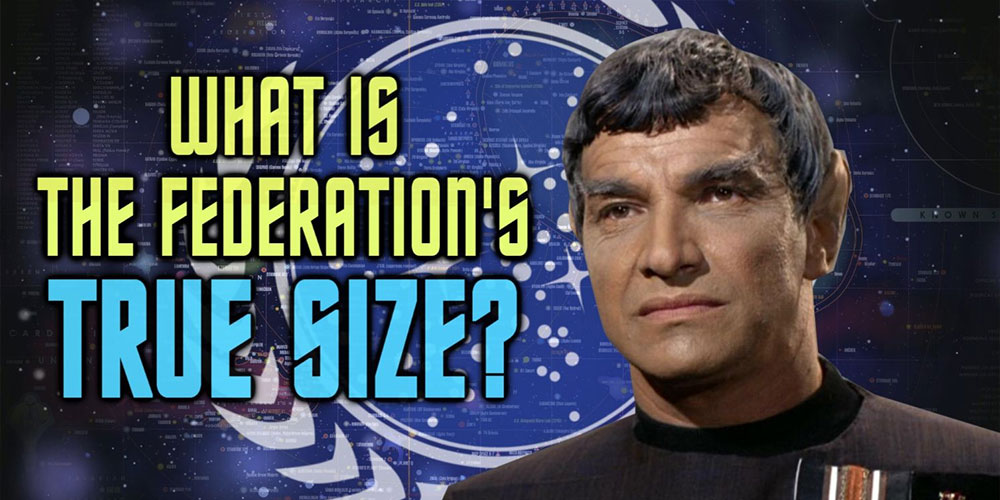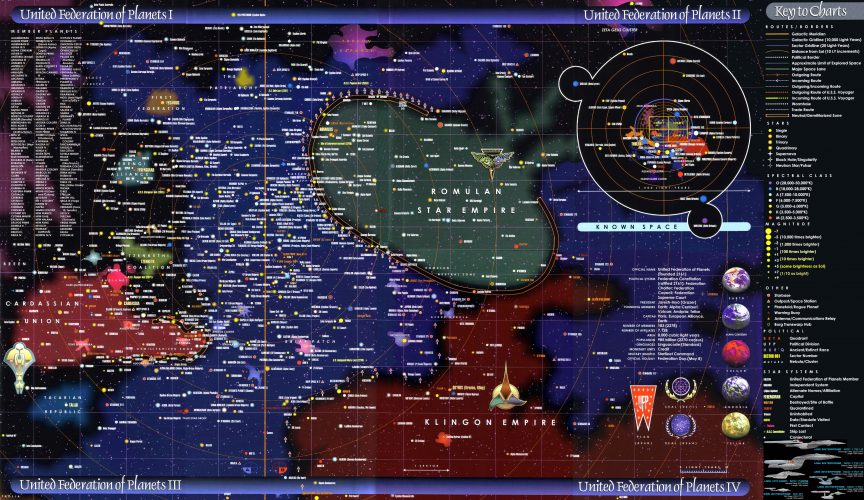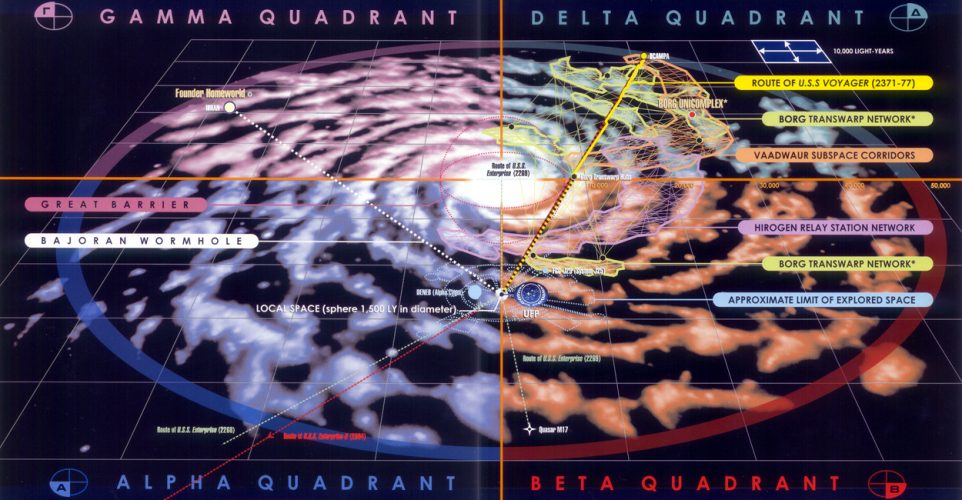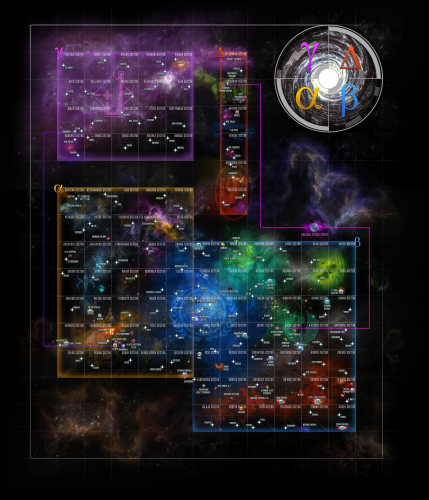Hey guys, what’s up? Tyler here. So, for Christmas last year, I got something to add to my collection of Star Trek reference books—Stellar Cartography: The Starfleet Reference Library by Larry Nemecek. Yes, it’s eight years old, but it’s one of the most recent major attempts to develop cartographic material for the Star Trek galaxy. I’ve had Geoffrey Mandel’s Star Trek: Star Charts for a few years, and while it’s certainly not up to date and has some mistakes, for a long time, it’s served as a standard-bearer for mapping Trek’s Milky Way.
I’ve made videos about mapping the Star Trek galaxy before, which you can watch on my channel. But with so many new entries in the franchise continuing to fill in the gaps of Federation space and its neighbours, I thought it was about time for another entry on this subject. Specifically, what I want to talk about is: how big is the Federation, really?
The answer to this question is more complicated than you might think. We’ve gotten rather nebulous figures of around 8,000 light-years across from sources like Star Trek: First Contact, but what does “8,000 light-years across” actually mean? Across, how? Space is three-dimensional, as I demonstrated in my 2018 video, “What Does Star Trek’s Alpha Quadrant Look Like?” So, “across” doesn’t have the same meaning as it would on a 2D map of, for example, the Earth’s surface.
The farthest member world referenced in canon is Antares, not to be confused with the home of the Antarans, who are featured in Enterprise. Antares is about 550 light-years away towards the galactic core. We are also given indication in The Next Generation pilot “Encounter at Farpoint” that Deneb, or Alpha Cygni, is just beyond the edge of Federation space at about 2,600 light-years away, in the “other” direction towards the edge of the galaxy.
But none of this makes any sense when you describe it as “8,000 light-years across.” If we assume cubic light-years, this doesn’t work either, because one sector—20 light-years wide, tall, and deep along the three spatial axes—is 8,000 cubic light-years, and obviously there are dozens if not hundreds of sectors in Federation space. Square light-years don’t make too much sense either, because based on the most accurate configurations, the total area of the Federation on a 2D map would be tens of thousands of light-years. But again, a square value doesn’t make sense for an object with three dimensions anyway.
This boils down, I think, to an alternative definition for what “across” means. 8,000 light-years is how much distance an Intrepid-class starship would cross in eight years, but a polity of that size seems too large to maintain. I believe the Federation is quite big based in part on how much influence it wields on the interstellar scene, but like the Roman Empire, it would have to be an entity that could be crossed in a matter of weeks, not years.
We really don’t know if this figure pertains to the territories of each of the Federation’s members, the distances from one extreme end to the other if it has anything to do with travel times, etc. Any way you slice it, 8,000 light-years just doesn’t seem to fit any established method of determining the size of Federation space. And there’s also the fact that, in Trek, speed and distance often serve the plot first, which is how Bajor can simultaneously be 50 light-years from Earth and on the “frontier” of Federation space in the 24th century.
This is why I think “across” pertains to some unit of measure that we wouldn’t particularly find useful in the 21st century because of our relative technological level. Eight thousand light-years can be huge according to some metrics and tiny according to others. I don’t know if there’s a clean way to resolve this; I think it’s a much more useful measure to describe how many member worlds the Federation contains.
Picard tells Lilly in First Contact that there are 150 member worlds, and this number is specified as 154 in The Articles of the Federation, set in 2381. This is somewhat analogous to the number of United Nations members, which is a comparison that would make sense to Lilly and the audience. Of course, James Kirk describes the Federation as being present on a thousand worlds and counting in the 23rd century, but this number almost certainly includes colonies, research outposts, planets with Federation embassies, and more.
As big as the Federation is, is it realistic that only 150 planets would have seats on the Council? I think so. Remember that Federation membership has rather strict rules, though these rules might have been more relaxed in its early years of expansion, explaining members such as Ardana with its segregated society. “Journey to Babel” implies there are 32 Federation members, because there are 32 ambassadors at the Babel Conference. While this may seem low for the 23rd century—in the Kelvin timeline, that number is 120 during this era—increasing and decreasing rates of expansion would explain how it might have stabilized at 150 during The Next Generation era and peaked at 350 later on, as we learn in season 3 of Discovery.
As for listing these members, that’s almost another video in and of itself…it’s not incredibly certain who does and does not have full member status at various points throughout the franchise. We get some indications in “Journey to Babel,” the Council scenes in Star Trek: The Voyage Home, and beyond—but a confirmed, canon list of Federation members by year would be a bigger feat, I think, than mapping the Star Trek worlds in three dimensions.
While we’re here, though, let’s see how much we can piece together based on what we know from canon as well as a few non-canon sources. First off, there are the four founding members of the Federation as established in Enterprise—Earth, Vulcan, Andoria, and Tellar Prime. Alpha Centauri is generally regarded to be a core founding member as well in some supplementary materials from Star Trek Generations—so that’s five.
Among the members we see at the Babel Conference are the Ithenites and a few unidentified species. Some of these races are identified in Star Trek Online as the Loktarans, the Violaceans, and the Makusians. The Original Series episode “The Cloud Minders” confirms that Ardana and Merak II are a members; the Rigel system, likely the fictitious Beta Rigel created for the franchise, is inferred as a member in “The Doomsday Machine”; the script for The Animated Series episode “Yesteryear” confirms the same for Aurelia, home of Federation historian Aleek-Om; and the novelization of The Motion Picture, which I’ve expressed scepticism of before, says Delta IV joined by this time as well.
We’re already venturing beyond what’s established on screen, but there’s only so much there to go on. The modern novel continuity includes Arken II, Cygnet XIV, Izar, Mars, Regulus, Sauria, Tiburon, Vega, and others as members by 2268; Star Trek Online extends this to Risa and Terra Nova; StarTrek.com, which does sometimes include mistaken information, includes Aldebaran; and various other modern reference materials include Argelius II, Betelgeuse II, Daran V, Deneb Kaitos, Denobula, Valakis, and Xi Hydrae.
That’s 32, meaning that if all of these worlds sent ambassadors and delegates to the Babel Conference, Coridan would have been the 33rd chartered member. Of course, since many of the sources suggesting these memberships are not canon, this information should be taken with a grain of salt. But I do think it’s a fun exercise to figure out which planets would have been full-fledged members and which ones would have simply been affiliates, trading partners, you name it.
By the late 23rd century, the period of The Original Series movies, additional Council members include the Arcadians, Ariolo, Bzzit Khaht, Caitians, Kasheeta, Mazorites, Xelatians, and Zaranites, and Federation presidents we’ve seen throughout Trek have included an Efrosian and a Grazerite. Many of the names of the aliens seen in The Voyage Home come from the non-canon Star Trek IV Sourcebook Update.
Other planets confirmed to be members in various episodes and films include the Algol, Arbaza, Barzan II, Benzar, Betazed, Bolarus IX, Gelrak V, Kaminar, Peliar Zel II, Trill, and the homeworlds of the Zakdorn and the Zelonites. This brings us to 55 member worlds, which is only around 15% of the total number of members at the Federation’s peak. And there are numerous other members confirmed in non-canon sources, including entire alien species that have never been featured before in canon materials.
The 120 figure for the number of Federation member worlds in 2258 of the Kelvin timeline is somewhat eyebrow raising considering everything I’ve just laid out. I’ve seen some people theorize, though, that the political configuration of the alternate reality Federation—perhaps stretching back even to its founding, should some time travel shenanigans be involved—is completely different from what it is in the Prime Universe. Alternate Earth, facing different circumstances throughout its history, would make alliances with some species that it hadn’t in the Prime timeline, and its accelerated rate of expansion—likely influenced by alternate Starfleet’s more advanced propulsion technology—would play a role in this.
So, how big is the Federation? Big. Small. It depends who you talk to, it depends what the context is, it even depends WHEN we are talking about. They certainly can’t take up more than 1 or 2% of the total volume of the galaxy, because even in 2364, only 11% of the Milky Way had been explored—we’ve since seen that number expanded, but when it comes to the amount of commitment it takes to become a Federation member, I actually don’t think it’s unreasonable for an entity such as the Federation, even if it were to operate on the scale of thousands of light-years, to “only” have 350 council members at its peak. Keep in mind, also, that much of Federation territory would also incorporate empty space or pre-warp civilizations unaware of their surroundings.
Thank you all for watching! I definitely want to hear your thoughts in the comments. If you enjoyed content like this, becoming a patron at patreon.com/orangeriver is a great way to support me.
Watch The Latest Video By Orange River Media Below
Don’t forget to subscribe, and I’ll see you next time! Live long and prosper.
You can find Orange River Media at the links below
- YouTube: https://www.youtube.com/orangeriver
- Twitter: https://www.twitter.com/orangerivernw
- Instagram: https://www.instagram.com/orangeriver.nw
- Facebook: https://www.facebook.com/orangerivernw
- Patreon: https://www.patreon.com/orangeriver















